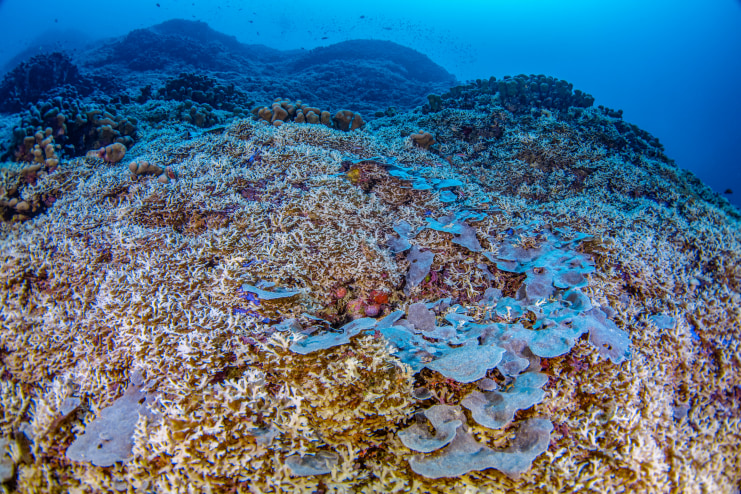News has spread like wildfire of the discovery of the world’s largest living coral colony. It was discovered last month in the Solomon Islands by National Geographic Pristine Seas team member and underwater cinematographer Manu San Félix, who dove down for a closer look when team members thought the dark shape on the sea floor may be the remnants of a shipwreck. What he found was one single, unbroken colony of the Shoulderblade coral, Pavona clavus measuring 34 meters wide, 32 meters long, and 5.5 meters high, with a circumference of 183 meters. The mega coral is three times larger than the previous record-breaker, is believed to be about 300 years old, and is storing a record of ocean conditions from past centuries. It can even be seen from space. Despite its size, the coral has never been documented, with the local community reporting they did not know it was there.
One billion polyps
“Just when we think there is nothing left to discover on planet Earth, we find a massive coral made of nearly one billion little polyps, pulsing with life and color,” said Enric Sala, National Geographic Explorer in Residence and founder of Pristine Seas. “This is a significant scientific discovery, like finding the world’s tallest tree. But there is cause for alarm. Despite its remote location, this coral is not safe from global warming and other human threats.”
“Large adult coral colonies like this contribute significantly to the recovery of coral reef ecosystems due to their high reproductive potential,” remarked Eric Brown, coral scientist for the Pristine Seas expedition to the Solomon Islands. Brown, who is one of the world’s premier coral scientists, had identified and measured the previous record-holding coral, located in American Samoa. “While the nearby shallow reefs were degraded due to warmer seas, witnessing this large healthy coral oasis in slightly deeper waters is a beacon of hope.”
Discovery of the mega coral comes when research has shown that only 8.4% of the ocean is protected to some degree. Scientific studies recommend that the world protect at least 30% of the ocean to maintain its role in absorbing much of our carbon pollution–as well as providing food, economic benefits, and employment for hundreds of millions of people. A recent study found that we need about 190,000 small MPAs in coastal regions and 300 large MPAs in remote areas by the end of 2030 to achieve the target.
“It is a natural monument that has seen the arrival of the first Europeans to these waters,” said San Félix, who was the first to spot the record-breaking coral. “Illustrious figures of humanity have coexisted with this colony: Newton, Darwin, Curie, Gandhi, Einstein… and it has survived them. It now stores information on how to survive throughout the centuries. The genetic code of these simple polyps is an enormous encyclopedia that has written how to survive multiple climatic conditions, and until now it does so in the face of ocean warming.”
The Solomon Islands hosts the second-highest coral diversity on the planet, boasting more than 490 known species, both hard and soft. It is also home to one of the world’s most active underwater volcanoes, Kavachi.
In mid-October, 18 scientists and filmmakers from National Geographic Pristine Seas embarked on an expedition to study ocean health in parts of the Solomon Islands. The months-long research trip — a partnership between National Geographic Pristine Seas, the Government of the Solomon Islands, key members of Ocean12, and the Solomon Island Ministry of Education and Human Resources Development (MEHRD) — is using cutting-edge technology to better understand the country’s marine ecosystem in hopes of advancing ocean conservation. Living and working aboard the Argo research vessel, the team of local and international crew members will assess the ocean’s health with deep sea cameras, SCUBA dive surveys, seabird counts, underwater visual surveys, environmental DNA (eDNA) sampling, and a new state-of-the-art submersible rated to 1,300 m depth.
Pristine Seas conducts research to support countries to fulfill their commitments to ocean protection. The team of international and local scientists and filmmakers study the health of the ocean, documenting its wonder through still photography and cinematography, to support ocean conservation efforts in collaboration with local communities.
Big Momma
Molly Timmers, Pristine Seas Lead Scientist on the Solomon Islands Expedition said: “Twenty years ago, while working for NOAA, I unexpectedly saw while towboarding on the west side of T’au in American Samoa what is now known as “Big Momma”, one of the largest recorded corals to date. Today I had the incredible opportunity to see an even larger coral in the Solomon Islands. While Big Momma looked like a huge scoop of ice cream plopped down on the reef, this newly discovered coral is as if the ice cream started to melt, spreading forever along the seafloor.”
Other giant Pavona colonies
This isn’t the first mega Pavona that’s been discovered. A year ago in October 2023, Vincent Chalias discovered a 10x30x8m tall Pavona clavus in North Bali, something he described as a “Nerdic Experience,” while a 17x24x10m monster was discovered in 2015 in Japan. A 19x19x13 meters tall one was also found on the Great Barrier Reef in 2017 so that species in particular has form for longevity, adaptability to a changing climate over the centuries as well as the capability of reaching gigantic proportions. It’s available in the aquarium trade too.



